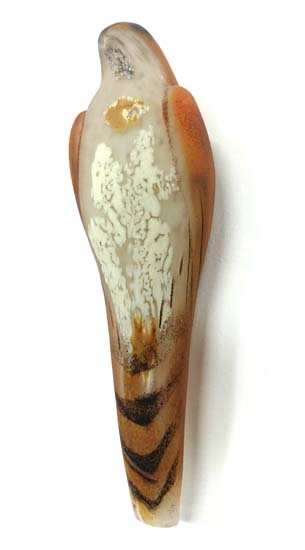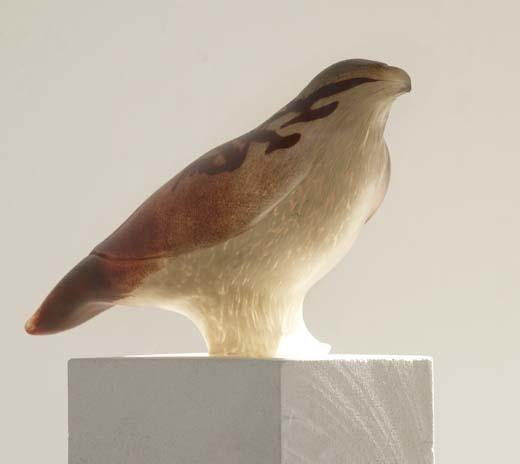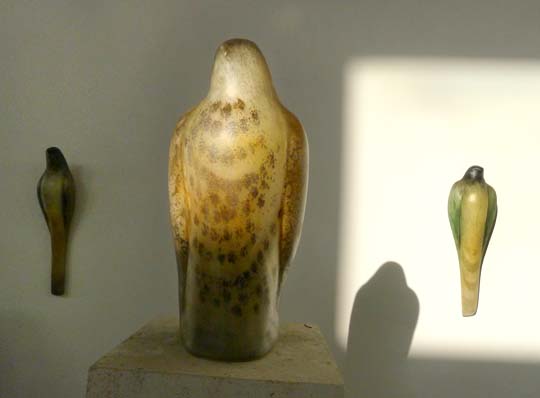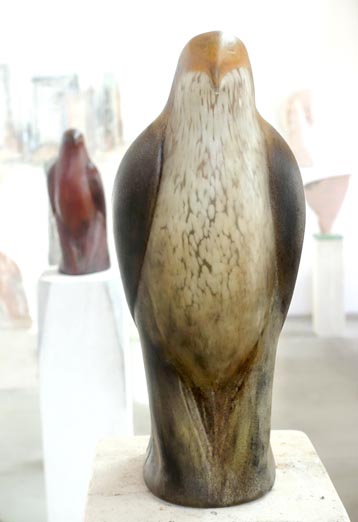Interviewsand Articles
A Conversation with Jane Rosen: Stay Here - Tell My Story
by Richard Whittaker, Sep 4, 2018

I met Jane Rosen not long after I’d begun publishing an art magazine. She was living in a rented house on a horse ranch near San Gregorio Beach forty miles south of San Francisco, and was unmistakably, a New Yorker. In fact, she was having a hard time making a decision. Would she make her career in New York, where she already had a great start, or trust her chances in northern California in the Bay Area? She’d gone back and forth, literally, over a period of some years from East Coast to West Coast and back. She’d taught at the School of Visual Arts in NYC and at Stanford in Palo Alto. And at one point, she was offered a tenured position at Bard, where she’d be teaching with a close friend, Judy Pfaff.
For an artist, Manhattan was the place to be. Living on a horse ranch three thousand miles away would seem the antithesis. But the climate, the natural beauty of the coastal hills, the wildlife and the quiet exerted a powerful call, and then something happened that settled the question. It had to do with a red-tailed hawk.
I’ve admired Rosen’s work for a long time, her drawings and her sculpture. Hawks have been a central part of that. For years, Rosen favored limestone and marble and then began to expand to glass. Recently she was excited about her new series of glass birds. It was the impetus for the following conversation and collection of images.—rw
.jpg)
Photo from Rosen's studio
works: It’s quite an involved process making these glass hawks, right?
Jane Rosen: Yes. Ross Richmond—he’s really a maestro—we’ve been working together for twenty years either at Pilchuck or Public Glass in SF. The last time we worked, we started using templates. We’d make them using a sheet of wood or plexiglasss and make drawings. We’d drill holes and put glass chips and powders in and bake the drawing at 25000 in a furnace or an oven and then pull it out. Think of a pizza tray. It becomes a drawing in glass that likens to the markings on an actual accipiter, one of the three hawks I’m very involved with—the cooper’s hawk, sharp-shinned hawk and goshawk.
works: And the red-tailed hawk, right?
Jane: I’m always interested in a red-tailed hawk. It’s the reason I’m in California. But these new glass wall birds I sent you images of are all accipiters and they look absolutely realistic. When you see one on a branch in a tree, it has that long, striped tail and they have shorter wings so they can dart in and out of the branches very tightly. No other hawks can do that.

So when we pull the lace out, which is what we call these glass drawings, they’re laying on a marver—a steel table. Then we take molten glass, and we have to think backwards and upside down, essentially, in order to place the drawings on this molten glass that’s going to be the hawk’s body. The lace drawings are for the chest and tail markings. We figure out where it’s going to be on the bird and roll the hot glass on to it. Then it stretches as you blow the glass out.
works: So they fuse, and the whole thing is shaped as it’s being blown?
Jane: Yes. It’s an incredibly complex process. You have to pull out the tail, for example, and then you work on the chest and get some of the markings in there by drawing it out. And the thing has to be turning constantly and going in and out of the furnace.
works: In order to keep it at the right temperature.
Jane: That’s right. If it gets a little too cool it will break and if it gets a little too hot, it will fall off the punty, which is the metal rod the glassblower uses.
works: Are the two of you working together?
Jane: Mostly. I stand over him and every once in a while, I will cut in. I direct making the lace. Sebastian Ages made the lace last time with me. I’m saying “Let’s use k54,” which is a certain transparent black. “Let’s use 161 frit #1,” which are chips of cream-colored glass. So I’m basically designing and working out the whole form with Ross and telling him where to pull more or longer, although he’s the master glassblower. We get completely in synch. Then, when we get where the tail and the chest are working, we have to change where the metal pipe is attached to where the head is going to be. Ross is in charge of all of this. After that, we have to change it and connect the punty on the back, or near the tail and heat it up again.
works: In order to shape the head, right?
Jane: Yes. And then we’re going to put more glass frit onto the head and part of the chest, and start shaping the head. It’s really complex because you have to know where the head is going to be and how the shoulders are going to be while you’re working on the tail and the back. The process is like an ancient alchemy. At the glass blow (artist) Jim Campbell said that with the intensity of attention Ross and I had with each other and with the glass, you could hear a pin drop. I’m there like a hawk, looking at every single thing. All Ross had to do was look up at me and I’d just indicate with my hand—“longer” or “more.”
There’s a great line—maybe I’ll want something to happen with the shoulders and I’ll ask, “Ross, do you think…“ And he says, “Not now!” [laughs]
works: He knows what you’re going to say.
Jane: He knows. And when he looks up at me, I don’t even need to know what he’s going to ask. I’ll just say, “Bigger.” [laughs] I know he’s asking, “Do you want the beak to be pulled down like this.” The beautiful beak.
He takes these tweezers and pulls the glass out from the head and pulls it down to a thread and cuts it off with scissors. We get that exact accipiter beak just from pulling a piece of glass and cutting it off. It’s sooo magical.
It’s slow, though. What I’m describing, the shaping and blowing and getting the markings just right, takes four hours. The red-tailed hawk, where we made these big brown and burnt sienna wings that we put onto the hawk—that piece is twenty-three inches long. It took seven hours to blow. So I’m standing there sweating. He’s standing there sweating and two assistants are there, because when it’s that big, you can’t even lift it. It’s probably thirty or forty pounds at the end of a six-foot pole that you’re holding up the whole time.
Then, in order to get the feet on that red tailed hawk, he made another glass ball, turned it into a cup and pulled it out from the bottom of the chest. For me, it was a once-in-a-lifetime event. It ends up looking like art, but you also end up wondering, “How did God make these?”
The tail is long on this accipiter (points) so he has an incredible rudder. He only lives on smaller birds and has to fly through branches of trees. The red-tailed hawk eats mice and rabbits and snakes, so he has way bigger and wider wings and a shorter tail.

works: Now you made an earlier glass version of the red-tailed hawk?
Jane: The glass red-tailed hawk is from a couple of years earlier. He was one of the first where we tried to make the lace drawings for the wings and then pull it onto the glass. It really was the forerunner of all of the wall birds. We learned a great deal from doing him and we’ve been learning more each time. It’s very hard to know exactly where the hole goes in the back so it sits well on the wall, how to get the exact right posture with head and shoulders, and the right proportions. Somebody at the glass blow said, “It’s unbelievable what the two of you can do with this glass bird in a few hours.” Ross just turned his head and said, “Yeah. Twenty years and a few hours.”
works: Why are you using the word “lace”?
Jane: We’re basically making glass lace in a similar way you’d weave lace. It’s like Ursula’s (Rydingsvard) pieces now. She calls them “lace” because they liken to lace collars.
Before this glass blow, when we were getting ready to work in person, I took photographs of hawks. I already had some of this glass lace and I would carefully tape the lace onto the various places on the hawk photo where I wanted it to be fused with the glass hawks that were going to be made, like on the chest or the wings. Then I put these carefully into a padded box and shipped it up to Ross in Seattle.
works: How long have you been working on making glass hawks? I know you’ve been carving stone hawks for a long time.
Jane: The glass hawks I started to try around 2000, or maybe as early as 1998. So literally, it’s taken twenty years to get these pieces. I mean, over the years there are glass wall hawks we’ve made, but these are really the first ones—not that I’m completely satisfied, there’s more I want to do, but with these—where I really feel there’s some understanding of being in relation to the process.
works: Earlier, when I brought up the red-tailed hawks, you said, “That’s the reason I’m here on the West Coast.” I wonder if you would repeat that story.
Jane: Sure. When I arrived from New York and got planted on this horse ranch where I was renting a house, I was supposed to go back to New York, which is my home. I couldn’t quite make up my mind what I wanted to do. Then one day I was walking and something called me. I looked up and there was a red-tailed hawk circling over my head. I heard a voice say, clear as day, “Stay here. Tell my story.”
works: That’s remarkable.
Jane: My friend, my teacher Ruth Cooke said, “You must stay here.” It’s important not just for your students, but for the whole country that you tell this story.
works: What is that story?
Jane: It’s embodying the red-tailed hawk to allow people to see what I see in nature, so they won’t destroy the nature we inhabit. That’s an important story to tell, especially now. There’s no respect for the stories and the legends of nature. We’re dominating nature and drilling holes in it and taking away its wildness.
works: Like we’re out on a limb and sawing it off.
Jane: Exactly. We’re definitely out on a limb. And the thing is, these beings—these hawks, these owls—can’t live in the environment we’re creating. I guess I feel that I can make these forms and show people what I see. When they buy them and are touched by living with them, they’ll have less of a tendency to turn a blind eye to the environment. The people who are buying my work are the rich Republicans; they’re the people who can destroy lands with fracking and development and so on. But if they see what I see, and feel the presence of that raptor, maybe they’ll feel a new respect.

works: Like nature isn’t just a supply depot to satisfy our short-term needs and desires.
Jane: We’re just visitors. Nature isn’t a supply depot for us. We’re not here to use nature this way. Just now, I’m sitting outside watching a squirrel and a lizard have a little exchange. I’m just watching.
As long as I was teaching at UC Berkeley, I would bring the students on trips to the ranch—especially the computer science students, because they tended to live in their heads. If I could get them to really experience nature, they were always touched and I could feel something shift.

See more on Jane's website.
About the Author
Richard Whittaker is the founding editor of works & conversations and West Coast editor of Parabola magazine.
SUBSCRIBE NOW
TO OUR MONTHLY NEWSLETTER









Share Your Comments and Reflections on this Conversation:
On Feb 18, 2020 PDA wrote:
I am always in awe when I see a red tail soaring near me, I’m careful to take the time to watch its movements, it’s perfect ability to adjust it’s flight path. And when it’s perched, I’m amazed at it’s incredible focus. By the same token, I marvel at the small birds, finches, sparrows, wrens sharing the bird bath dipping in the water, flapping their wings and thoroughly enjoying the little pleasures. Odd that so many don’t recognize the wonder of simple nature around them.On Feb 18, 2020 Jmk wrote:
Interesting, until you got to rich republicans. Stop already with vilification and stereotyping! This is why we have Trump. It’s the constant insults and the misunderstanding and assumptions made by the left that made for the Trump rebellion.